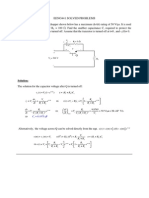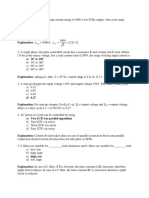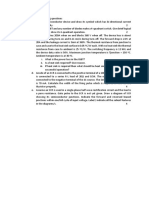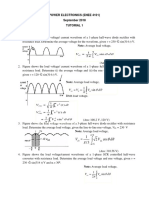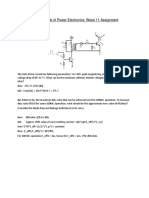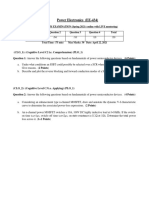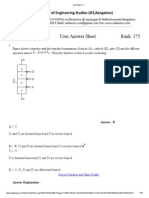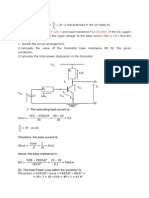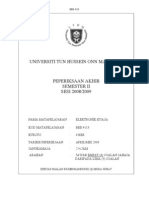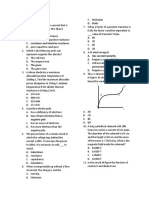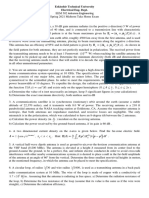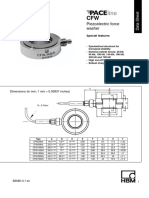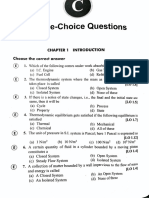TSTE19 Power Electronics Examination (TEN1)
Uploaded by
Onur AydınTSTE19 Power Electronics Examination (TEN1)
Uploaded by
Onur Aydın2016-03-30
TSTE19
SOLUTIONS TEN1
1(13)
TSTE19
Power Electronics
Examination (TEN1)
Time: Wednesday 30th March 2016 at 8:00 – 12:00
Place: TER4
Responsible teacher: Tomas Jonsson
Will visit the exam location at 8:45 and 10.
Number of tasks: 6
Number of pages: 12
Allowed aids: Calculator
Total points: 70
Notes: A pass on the exam requires approx. 30 points.
Describe your calculations clearly and detailed, explaining
your methods, assumptions and equations used.
When a question is dependent on result from an earlier
question which you fail to complete, then its better to assume
some value for this result in order to present the calculation
methodology.
LINKÖPING UNIVERSITY
ICS/ISY
LINKÖPING UNIVERSITY TSTE19
ICS/ISY SOLUTIONS TEN1
2(13)
Question 1
Id Ld
Ls
Usa
Usb +
Load
Ud
Usc
-
Figure 1
a) A three-phase diode rectifier according to Figure 1 is connected to the
sinusodial ac-voltages Usa, Usb and Usc. The ac-voltages have 120 degree (2)
phase shift in the order a-b-c. Define the order in which the diodes will
conduct by assigning numbers (1-6) to each diode.
Answer: The upper diodes: 1, 3, 5. The lower diodes: 4, 6, 2
b) A diode rectifier according to Figure 2: has an inductance, L, and a
voltage source Ed on the dc-side. How will the current, i, change if the (2)
dc-voltage Ed is increased.
Figure 2:
Answer: The current will decrease.
c) A full-bridge inverter is producing an output voltage, o, with the
harmonic spectra according to Figure 3, where mf is the frequency
modulation index. Draw the voltage waveform and state the name of
the PWM switching scheme used.
Answer: See waveform W2 in question 2. Unipolar switching.
(2)
Figure 3
LINKÖPING UNIVERSITY TSTE19
ICS/ISY SOLUTIONS TEN1
3(13)
d) List three types of semiconductors which has the capability to turn-off (3)
current by the action of a dedicated control input.
Answer: BJT, MOSFET, JFET, IGBT, GTO, IGCT
e) For each of the four converter circuits below find the corresponding
waveform figure that presents the main voltage and/or current. One (3)
wave form for each circuit only.
Answer: C1 - W8, C2 – W5, C3 – W3, C4 - W6
C1
C2
C3
C4
LINKÖPING UNIVERSITY TSTE19
ICS/ISY SOLUTIONS TEN1
4(13)
W1
W2
u
W3
W4
u uo1
W5
W6
W8
W7
LINKÖPING UNIVERSITY TSTE19
ICS/ISY SOLUTIONS TEN1
5(13)
Question 2
Ld
id
isa +
usa
isb +
usb Ud
Load
uv
usc isc -
-
Figure 4
A three phase thyristor rectifier as shown by Figure 4 is connected to a voltage source
with a phase-ground voltage Us=240 Vrms. The commutation inductance can be
neglected and the dc-side current considered smooth through the inductance L d.
a) Calculate the average dc-load voltage, Ud, for a firing angle α=20 deg. (2)
Answer: Ud = 1.35*sqrt(3)*Us*cos(alpha) = 527 V.
b) Determine the average dc-current considering a resistive load of 4 kW.
Answer: Id = 4000/Ud = 7.6 A (2)
c) Determine the displacement power factor.
(2)
Answer: DPF = cos(alpha) = cos(20) = 0.94.
d) Calculate the ac-side fundamental frequency rms current (isa). Assume
zero losses of the thyristor converter. (2)
Answer: Isa = 4000/DPF/3/240 = 5.9 A.
e) Draw the waveform of the three phase source currents, isa, isb and isc.
1.5
1
(2)
0.5
isa
0
isb
-0.5 isc
-1
-1.5
0 60 120 180 240 300 360
LINKÖPING UNIVERSITY TSTE19
ICS/ISY SOLUTIONS TEN1
6(13)
f) Determine the reactive power.
Answer: Q = 3*Us*Is*sin(alpha) = 1.46 kVAr (2)
Question 3
T1
iL
Ud L
D1 C R
Figure 5
In the buck converter in Figure 5 which is feeding a resistive load, R=2 ohm, the
current, iL, should be continuous. The MOSFET T1 is operated with a switching
frequency fsw = 120 kHz and a duty cycle of 0.75. The input voltage Ud = 12 V.
a) Determine the average output voltage, Uo, across the load resistance. (3)
Answer: Uo = D*Ud = 9 V
b) Determine the average current through the inductance L.
Answer: iL = Uo/R = 4.5 A (2)
c) Determine the minimum inductance related to continuous current and
calculate the peak current through the inductance L. Assume the output (4)
capacitance C is large enough to get a smooth voltage.
Answer: Lmin = (Ud-Uo)*D*tsw/(2*iL)=2.1 µH, iLmax=2*iL=9 A.
d) Draw the waveforms of the inductor voltage, inductor current and MOSFET (2)
current during one switching cycle considering the minimum inductance for
continuous current.
Answer: See figure W8 of question 2.
Question 4
A buck converter as in Figure 5, is operated at the limit between continuous and
discontinuous current with a peak inductor current of 20 A. The converter is operated
with a switching frequency fsw = 50 kHz and a duty cycle of 0.75 which gives an output
voltage of 12 V.
a) Calculate the RMS value of the MOSFET T1 current.
(4)
LINKÖPING UNIVERSITY TSTE19
ICS/ISY SOLUTIONS TEN1
7(13)
√ √
Dtsw
i Lmax ² 1 i Lmax t
² 3 Dt
1
√ D
sw
Answer: I t 1RMS =
t sw
∫ (
Dt sw
t) dt = ( ) [ ] =i Lmax
t sw Dt sw 3 0 3
0
It1RMS=4.5 A
b) Calculate the conduction losses in the MOSFET T1 if the on-state resistance
(3)
Rds(on) = 0.05 ohm.
Answer: PT1 = Rds(on)*It1RMS^2 = 5.0 W
c) Determine the efficiency of the converter assuming switching losses and
(2)
diode losses to be negligible.
Answer: The output power Po is defined by the average inductor
current and the output voltage. Po = 12*10 = 120 W. The efficiency
n=Po/(Po+PT1) = 120/(120+5) = 0.96
d) Determine the required thermal resistance of the heatsink (R thHA) for the
(4)
MOSFET T1 in order to keep the heatsink temperature, T H ≤ 70 C and the
junction temperature, TJ ≤ 100 C. The MOSFET has a thermal resistance
RthJH = 12.0 C/W. The ambient temperature, TA = 25 C.
Answer: Based on TJ ≤ 100 C: RthHA = (TJmax – TA)/PT1 - RthJH = 3 K/W
Based on TH ≤ 70 C: RthHA = (THmax – TA)/PT1 = 9 K/W
Consequently, to satisfy both TJmax and THmax the minimum RthHA = 3
K/W should be selected.
LINKÖPING UNIVERSITY TSTE19
ICS/ISY SOLUTIONS TEN1
8(13)
Question 5
Lc
+ T1
Ud/2 D1
- L
Iv
+ +
Uv Uac
- -
+ T2
Ud/2 D2
-
Figure 6
A half-bridge voltage source converter is connected between a dc-source and an ac-load
as shown by Figure 6. The dc-side has a parasitic inductance Lc = 70 nH. The control of
the switched output voltage is done through pulse width modulation (PWM) with a
switching frequency fsw=950 Hz, in order to obtain a 50 Hz voltage component with a
defined magnitude.
a) What is the maximum amplitude modulation ratio, ma, for a dc-side
(4)
voltage, Ud=48 V when the rms magnitude of the 50 Hz component,
Uv1, shall be controllable between 10 Vrms and 15 Vrms.
Answer: mamax = sqrt(2)*15/(48/2) = 0.88.
b) Consider an interval during switching where initially Diode D2 is (3)
conducting and consequently the current Iv is positive. Draw the
waveform of current and voltage of T1, D1, T2 and D2 for the
switching sequence listed below. Assume the current Iv is constant
during this interval. Consider the rise and fall times for both current
and voltage to be 1 µs.
◦ t = 1 µs, T2 turn-off
◦ t = 5 µs, T1 turn-on
◦ t = 10 µs, T1 turn-off
LINKÖPING UNIVERSITY TSTE19
ICS/ISY SOLUTIONS TEN1
9(13)
◦ t = 15 µs, T2 turn-on
25 (3)
20
It1
15
Id1
Vt1
It2
10
Id2
Vt2
0
0 2 4 6 8 10 12 14 16
c) Determine the rate-of-rise of current through a MOSFET at turn-on,
considering very fast gate control causing the voltage across the
MOSFET to fall to zero instantaneously. E.g. consider the case when
D2 is conducting, T2 is off and T1 is turning on. The dc-voltage Ud
shall be considered to be constant, related to a large capacitance.
Answer: dI/dt=Ud/Lc = 48/70 [V/ns] = 0.69 V/ns.
LINKÖPING UNIVERSITY TSTE19
ICS/ISY SOLUTIONS TEN1
10(13)
Question 6
A gate drive shall be designed for the half-bridge converter in Figure 6. An
equivalent circuit to analyze the switching of the MOSFET T1 is shown in Figure 7.
Here the MOSFET is represented by the capacitances C gd=150 pF, Cgs=1.5 nF and a
current source Ids. Figure 8 shows the switching waveforms of the voltages and current
through the MOSFET. The gate is controlled by the voltage VGG which switches
instantaneously from 0 V to 15 V at turn-on. The current Iv can be considered to be
constant, and flowing out of the converter.
T1
RG CGD +
+ IDS VDS
+
Ud VGG VGS CGS - Iv
- -
D2
Figure 7
Figure 8
a) Determine the turn-on delay, t1 of the MOSFET, from the time when VGG
(4)
switches from 0 V to 15 V to the time when the current I ds starts rising.
Rg = 680 ohm, Vth = 3 V.
Answer: The gate voltage rises related to charging of the gate
capacitance Cgs through the gate resistor from a constant voltage source
−t
VGG = 15 V. V GS=V G G (1−exp ( ))
R g⋅C gs
LINKÖPING UNIVERSITY TSTE19
ICS/ISY SOLUTIONS TEN1
11(13)
(V G G −V th )
t 1=−R g⋅C gs ln( )=0.23 µs
V GG
b) Determine the total delay, t2 of the MOSFET, until full current Iv = 12 A is
(3)
reached. Consider a rate of rise of drain current dI ds/dt = 10 A/µs.
Answer: The current raises linearly up to the load current Iv=12 A. We
assume that the diode has an ideal turn-off at this point.
Iv
t 2 =t 1 + =1.4 µs
dI ds / dt
c) Determine the rate of decay of the voltage across the MOSFET, dV ds/dt,
during the time when the gate voltage VGS is constant at the plateau level (5)
VGP = 7 V.
V G G −V GP
Answer: The gate current is ig = . The voltage derivative
Rg
dVds/dt will be equal to the voltage derivative of the Cgd capacitance. The
relation between current and voltage derivative for the Cgd capacitance
dV
is igd =C gd⋅ ds . Since the gate voltage is constant all gate current is
dt
passing through the Cgd capacitance.
dV ds V GG −V GP
igd =i g ⇒ = =78 V / µs
dt R g⋅C gd
LINKÖPING UNIVERSITY TSTE19
ICS/ISY SOLUTIONS TEN1
12(13)
Formula collection TSTE19 Power Electronics
Fourier series coefficients using symmetry,
Undamped resonant circuits
LINKÖPING UNIVERSITY TSTE19
ICS/ISY SOLUTIONS TEN1
13(13)
Integration rules
You might also like
- Tutorial 1 - Basic Concepts in Power Electronics100% (2)Tutorial 1 - Basic Concepts in Power Electronics7 pages
- University of Zimbabwe: Power Electronics and Motion Control: Ee420No ratings yetUniversity of Zimbabwe: Power Electronics and Motion Control: Ee42010 pages
- Power Electronics (Enee 4101) September 2018 Tutorial 1: D V V VNo ratings yetPower Electronics (Enee 4101) September 2018 Tutorial 1: D V V V8 pages
- Fundamentals of Power Electronics: Week 11 AssignmentNo ratings yetFundamentals of Power Electronics: Week 11 Assignment5 pages
- EE 5021: Power Converter Analysis and Design Sept2020-Jan2021 Assignment 3No ratings yetEE 5021: Power Converter Analysis and Design Sept2020-Jan2021 Assignment 33 pages
- Marks: - 7.35 User Answer Sheet Rank: 175: Institute of Engineering Studies (IES, Bangalore)No ratings yetMarks: - 7.35 User Answer Sheet Rank: 175: Institute of Engineering Studies (IES, Bangalore)18 pages
- EE4063 Power Electronics and Applications II - 2021 MayNo ratings yetEE4063 Power Electronics and Applications II - 2021 May5 pages
- IES OBJ Electrical Engineering 1997 Paper IINo ratings yetIES OBJ Electrical Engineering 1997 Paper II16 pages
- One Mark Questions (Q.1 To Q.6) : Common InstructionsNo ratings yetOne Mark Questions (Q.1 To Q.6) : Common Instructions2 pages
- University of Zimbabwe: Power Electronics and Motion Control: Ee420No ratings yetUniversity of Zimbabwe: Power Electronics and Motion Control: Ee4208 pages
- EE333_Exam 2_2023-2024 sem 2_V2_ans key.docx (1) (1)No ratings yetEE333_Exam 2_2023-2024 sem 2_V2_ans key.docx (1) (1)12 pages
- EE333_Quiz_2023-2024 sem2_V3_Ans key (1)No ratings yetEE333_Quiz_2023-2024 sem2_V3_Ans key (1)5 pages
- Design of Electrical Circuits using Engineering Software ToolsFrom EverandDesign of Electrical Circuits using Engineering Software ToolsNo ratings yet
- Pvsyst - Simulation Report: Grid-Connected SystemNo ratings yetPvsyst - Simulation Report: Grid-Connected System6 pages
- Piezoelectric Force Washer: Special FeaturesNo ratings yetPiezoelectric Force Washer: Special Features4 pages
- Paper: Advanced Pattern Part Test-1 (Apt-1)0% (1)Paper: Advanced Pattern Part Test-1 (Apt-1)21 pages
- Unequal Angles... BS EN 10056-1:1999: BSI ShopNo ratings yetUnequal Angles... BS EN 10056-1:1999: BSI Shop3 pages
- Negative Viscosity Effect in A Magnetic FluidNo ratings yetNegative Viscosity Effect in A Magnetic Fluid4 pages
- Some Basic Concepts of Chemistry Shobhit Nirwan100% (6)Some Basic Concepts of Chemistry Shobhit Nirwan15 pages
- Dr. R. Saravanathamizhan Associate Professor Department of Chemical Engineering SSSN College of Engineering Kalavakkam - 603 110, ChennaiNo ratings yetDr. R. Saravanathamizhan Associate Professor Department of Chemical Engineering SSSN College of Engineering Kalavakkam - 603 110, Chennai25 pages
- Dynamics of A Particle - Level 3 - SolutionsNo ratings yetDynamics of A Particle - Level 3 - Solutions11 pages
- CAT - DPP - Arithmetic - Session - 23 - Time Speed & Distance - Part - INo ratings yetCAT - DPP - Arithmetic - Session - 23 - Time Speed & Distance - Part - I5 pages
